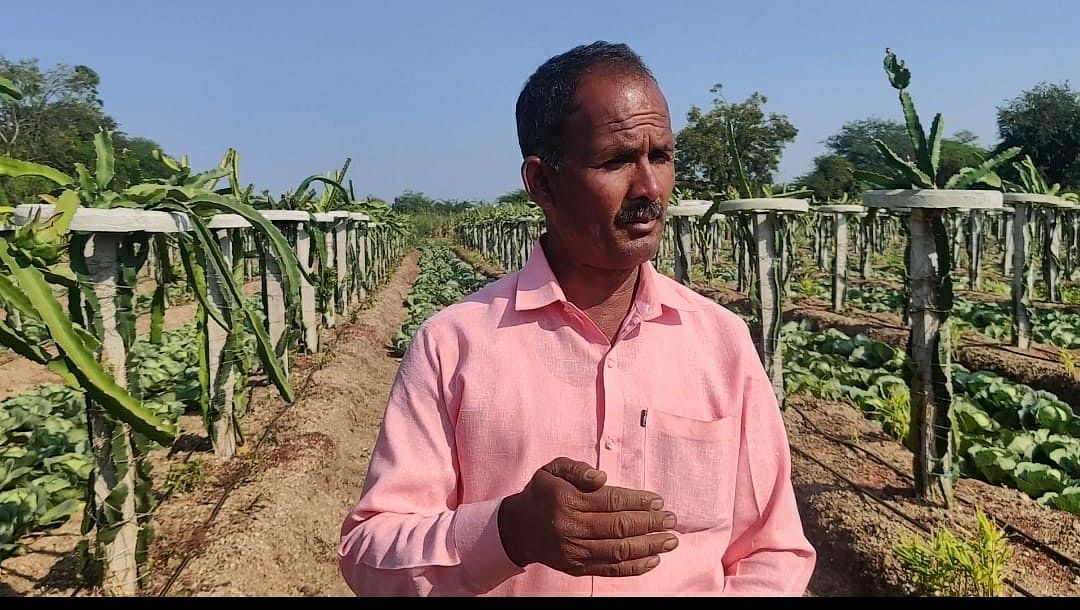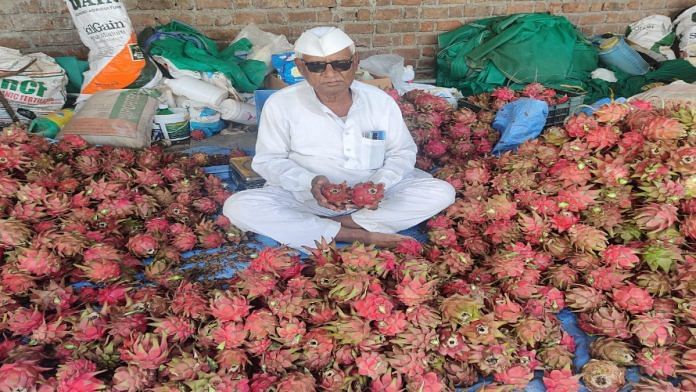Sangli, Maharashtra: Several farmers in western Maharashtra’s Sangli district have switched from the cultivation of traditional crops like sugarcane, grapes, soybean and other vegetables to the more exotic dragon fruit.
Sangli is among the drought-prone regions in Maharashtra but despite this, a large area in the district is under sugarcane cultivation, which is a water-guzzling plant but gives higher yields. This year, the area under sugarcane plantations in the state has increased by 2.55 lakh hectares — from 12.32 lakh hectares last year to 14.87 lakh hectares — according to official data.
State agriculture officials say the cultivation of dragon fruits is in demand, however, so far, only a handful of them have actually opted for this farming, they said.
Prakash Suryavanshi, agriculture superintendent, Sangli, told ThePrint, “There are currently very few farmers in Sangli who are growing dragon fruit. But farmers are hopeful.”
According to the Union Commerce Ministry, “Production of ‘dragon fruit’ commenced in India in early 1990s and it was grown as home gardens. Due to high export value, the exotic ‘dragon fruit’ has become increasingly popular in recent years in the country and it has been taken up for cultivation by farmers in different states.”
Also Read: Why sugarcane farmers in Maharashtra are up in arms against mill owners
Why the switch
About 10-15 farmers in Sangli’s Tadsar and Wangi villages have switched to dragon fruit farming, say local farmers.
Anandrao Pawar, a farmer who has been growing dragon fruit for the past six years in Tadsar, said that the reason why only a handful farmers have chosen dragon fruit over traditional crops could be that the initial investment is quite high.
“I had to put in around Rs 15 lakh when I first started growing dragon fruit. But now, I am reaping its benefits. I recovered half the money in the first year itself,” he said.
Rajaram Deshmukh, a farmer in Wangi village, said, “More and more farmers are now shifting to the cultivation of dragon fruit. I already planted the fruit in two acres. I am now thinking of cutting down my sugarcane field by another acre and growing dragon fruit there as well.”
The area is traditionally drought-prone but since dragon fruit requires less water its cultivation is hassle-free, Deshmukh added.
Dragon fruit is one of the several fruits grown out of cacti and does not require much water and grows in soil that has higher retention ability. There are three main varieties of dragon fruit: white flesh with pink skin, red flesh with pink skin, and white flesh with yellow skin.
Both Anandrao Pawar and Rajaram Deshmukh were the first farmers in the country in 2021 to have exported their dragon fruit variety to Dubai. Pawar and Deshmukh grow the jumbo red and pink and white and pink varieties.
Deshmukh says sugarcane gives him about 2 tonnes per acre but with dragon fruit, he gets about 15-18 tonnes, which is Rs 12-13 lakh per year.
“If I take out the expense from sugarcane, I hardly get a profit of Rs 1 lakh. With dragon fruit, my profit is Rs 8-9 lakh per year,” he said.
“This plant is low maintenance and I don’t have to worry even if there is a drought or hailstorm. It doesn’t even require any chemical pesticide,” he added.
This year, Deshmukh exported around 50 kg to New Zealand while he domestically sold the fruit to Hyderabad, Bengaluru, and even Guwahati, he said.

Pawar, too, took out some of his sugarcane and replaced it with dragon fruit. “This fruit does not require water during summers. It gets sunburned, otherwise. It saves a lot of water,” he said.
Inspired by Pawar and Deshmukh, Nanasaheb Mali, another farmer in Wangi, removed his grape field in two acres and opted for dragon fruit cultivation in 2021. He is planning to increase the cultivation by another two acres.
“I took out grapes because they were getting destroyed in drought-prone conditions and uneven rain. Covid-19 pandemic (in 2020) added to my woes and I didn’t get a good rate for my grapes. So I wanted a change,” said Mali.
Also Read: Roadshows with a flying beast: Why Syngenta plans to introduce drones for Indian farmers
Leap of faith or well thought out decision?
Pawar said that in 2013 one of his colleagues had told him about a farmer in Solapur who got an income of Rs 27 lakh in a year from cultivating one and a half acres with dragon fruit.
“That got me thinking. For the next three years, I researched this and discussed it with the farmers in and around my village. I cultivated the dragon fruit in my field for the first time in 2016,” he added.
He said that in 2017 he got 200 kg of production, in 2018 it grew to 1,500 kg, the third year (2019) it reached 3,700 kg. In 2020, Pawar got a produce of 7,500 kg, and last year, 8,500 kg.
“This year, I have already got about 7 tonnes (7,000 kg) and expect over 2 tonnes more this month. Next year, I expect a total of 18 tonnes (18,000 kg) production. So I expect this to grow further,” Pawar said.
(Edited by Anumeha Saxena)
Also Read: New Maharashtra govt outreach to curb farmer suicides requires officials to spend time at farms



